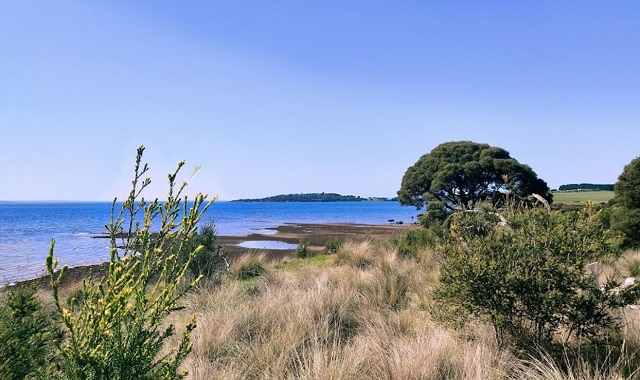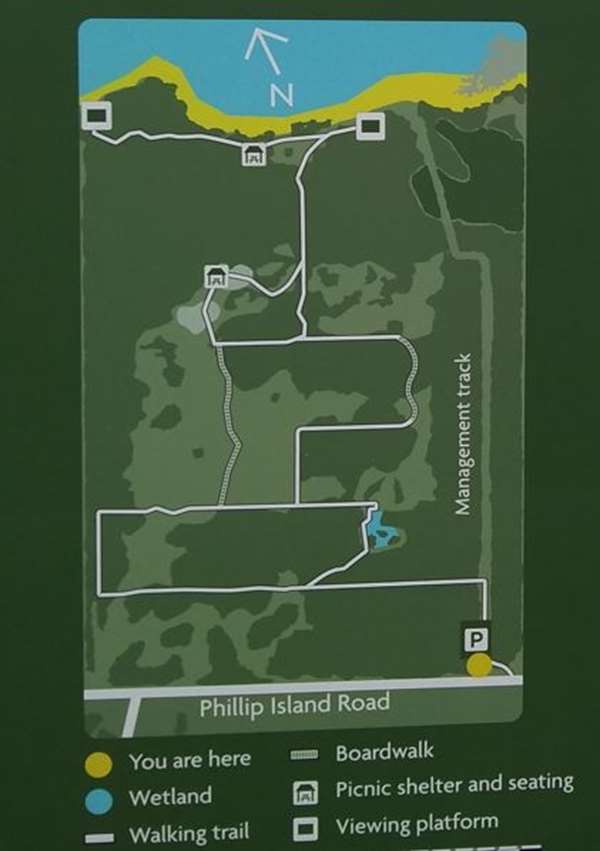Scenic Estate Conservation Reserve (Phillip Island)


Scenic Estate Conservation Reserve is a 28ha nature and wildlife reserve with interpretive walks, picnic areas and a wetland viewing platform.
The reserve is well known for its birdlife, providing habitat for six species of threatened birds and endangered grasslands and vegetation, as well as lovely bay views to Churchill Island, Rhyll and beyond.
There is an array of walks consisting of 1500 metres of walking tracks connecting the attractions and 195 metres of boardwalk through the native grasslands.
The reserve has had a varied history ranging from a dairy farm in the 1950's to an inappropriate housing subdivision in the 1960's followed by years of rubbish dumping, illegal camping and uncontrolled vehicle access. After rehabilitation the reserve was opened to the public and is testimony to the resilience of our indigenous flora.

A summary of facilities is:
- Difficulty - Easy
- Distance - 1.5km of walking tracks and 195m of boardwalks
- Start / Finish - Boobialla Road (off Phillip Island Road)
- Pram friendly
- Carpark and picnic areas
Access for Dogs:
Dogs are not permitted on the foreshore reserve, but they are allowed on a leash in other areas.
Wildlife in the Reserve
Scenic Estate Conservation Reserve provides a safe habitat for indigenous fauna, so as you make your way along the tracks, listen and look out for:
- Small bush birds darting past, including White-browed Scrubwrens, Red-browed Finches, Silver-eyes, New Holland Honeyeaters and the vivid blue of the male Superb Fairy Wrens
- Larger birds such as Wattlebirds, Ravens, Kookaburras, Magpies and Mudlarks
- Blue-tongued Lizards and Skinks sunbaking in the grass, or if you're very lucky, a Copperhead Snake (we always leave them well alone!)
- Shy mammals such as Swamp Wallabies and Echidnas
Ephemeral Wetlands
These wetlands were constructed in 2015 to rehabilitate an area where the soil and vegetation had been badly damaged by the uncontrolled use of off-road vehicles. Planting was carried out in the period 2015-17.
The wetlands are called ephemeral because they dry out each summer, when the plants that survive here become dormant. During wet times of the year the ponds fill with water partly from direct rainfall, partly from overflowing drains, and partly from ground water as the water table rises. As with much of Phillip Island, the groundwater is moderately saline, so these wetlands are home to plants that tolerate some salt.
If there is water in these wetlands look for Water Ribbons (with their broad straplike leaves) and Spike-rush and Juncus (which have narrow needle like leaves).
The succulent groundcover Noonflower covers parts of the banks, with showy purple flowers in spring, and a distinctive orange hue to its leaves over summer. There are also native grasses like Coast Tussock-grass and Wallaby Grass thriving on the banks.
Native Grasslands
Look for Milky Beauty-heads flowering in summer.
You are walking over native grasslands classed as 'critically endangered' in Victoria due to land clearing for farming and housing in the past. These brackish grasslands are so called because of the moderate levels of salt in the soil.
Coast Tussock-grass is the main plant species you can see, but other native grasses like Wallaby Grass and Weeping Grass are also found here, as are several different orchids. You might notice the delicate ground-cover, Milky Beauty-heads, which is conspicuous in summer with its white globe-shaped flowers contrasting with its small grey green leaves.
These native grasslands were not planted, but remarkably came back of their own accord after grazing stopped, even though the land had been completely cleared and sown to pasture in the 1950s. Perhaps this rapid return of native species was because the dairy farm operated for only 10 years, and the soil remained a little too salty for introduced pasture grasses to survive.
Coastal Moonah Wetland
-embed03.jpg)
Look for the slightly sticky leaves of the Sticky Hop-bush.
The graceful trees you see growing here are Moonahs, a long-lived species. The larger trees may well have been here before the first Europeans arrived.
Along with the Moonahs, you will find several other trees growing:
- Sweet Bursaria with its dense sprays of white, perfumed flowers in summer
- Sticky Hop-bush with its slightly sticky leaves
- The spiky Hedge Wattle with its brilliant orange-yellow spring flowers
The Moonah Woodland here is under threat from the eroding coastline, with some trees teetering on the edge of the cliff, ready to fall at any time. To help save the Moonah Woodland, more Moonahs are being planted away from the cliffs, and more mangroves are being planted on the shore to slow down erosion.
European Land Use
From 1842, the McHaffie family leased the whole of Phillip Island for sheep grazing, until the Island was opened up for 'Closer Settlement' in 1868. Scotsman John Love became the first owner of this block at that time, and settled here with his wife in a wattle and daub shack. After John Love's death in the early 1880s, the Cleeland family grazed sheep here until 1950.
At this time, Arthur Heritage purchased this 28 hectare site and proceeded to clear the land and create a small dairy farm. The simple cottage, some farm sheds and an extensive vegetable garden were located close to the coast near here.
Following the Heritages' retirement in 1960, the land was turned into the Scenic Estate residential subdivision, with 332 blocks surveyed and roads constructed, some of which are in use today as walking tracks. This development was short-lived, however, with no building allowed due to the swampy nature of much of the land. Decades of neglect and misuse followed.
50 years passed before ownership of the blocks could he returned to the public, and the present Conservation Reserve created. The native plants have regenerated strongly and the land gradually being restored.
Swamp Scrub
-embed04.jpg)
You are passing through swamp scrub vegetation, found in flat areas which are water-logged during winter and spring in most years. Large areas of this Reserve carry this type of vegetation.
The dominant plant species here is Swamp Paperbark, which takes its name from the papery bark on the trunks, as you can clearly see here. It has white, brush-shaped flowers in spring and is the most common tree on the Reserve. Other plants you can see in this area are the large tussocks of Coast Saw-sedge.
This type of vegetation is classed as 'endangered' in Victoria, as much of it has been lost through land clearing and drainage of swamps.
Review:
There's a lovely butterfly artwork in the corner of the car park which moves in the wind.
The reserve is well signposted with maps at each intersection of tracks and there are a number of information signs. There are seats beside the track at different places. The trails are wide, hard gravel or boardwalk, which makes it very easy to see any snakes which might be sunning on the path.
The wetlands are ephemeral, which means that it may not have any water during parts of the year.
Dogs are permitted on leash, but once you get to the lookout area with lovely views, dogs not permitted at all. This means that the most interesting part of the walk is not accessible to those with a dog.
In March we saw a fair number of colourful wildflowers on the path to the north-west look-out. Near that lookout there was a shelter with table and a circular sandpit (I'm assuming for kids to play in).
-embed02.jpg)
There are two lookouts where there are views across Westernport and this is definitely the best part of the walk. Make sure you go on both boardwalks because they are run through very different habitats - swamp versus meadow.
The reserve does not have a toilet or water tap.
Photos:
Location
Boobialla Road, Surf Beach 3922 View Map









